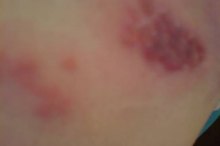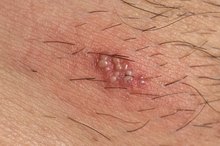Shingles Symptoms: Nausea
People who come down with shingles, which is actually the reoccurance of chicken pox, often mistake their initial symptoms for the beginnings of a flu. In addition to headache, fever and chills, nausea is a common symptom that can occur during the prodromal, or first stage of shingles, several days before the signature rash appears.
If you are experiencing serious medical symptoms, seek emergency treatment immediately.
Warning Sign
It makes sense that nausea often precedes and accompanies shingles, because the urge to vomit is a common way for the body to react when any infection is present. The flu-like symptoms announcing the onset of shingles may continue as the virus becomes active and the accompanying rash turns into painful blisters. Whether you are receiving medical treatment for shingles or just waiting to see what surfaces, there are steps you can take to diminish the unpleasant feeling of nausea.
- It makes sense that nausea often precedes and accompanies shingles, because the urge to vomit is a common way for the body to react when any infection is present.
- The flu-like symptoms announcing the onset of shingles may continue as the virus becomes active and the accompanying rash turns into painful blisters.
Coping with Queasiness
Is it Safe to Travel with Shingles?
Learn More
Stick to very small servings of bland, high-carbohydrate foods, such as:
- banana
- rice
- applesauce,
- toast or soda crackers
Sip clear fluids, such as water, broth or herbal tea, often between and during meals. It sometimes helps to suck on ice pops or chips of ice. If you are already taking medication to treat the virus and feeling nauseas, speak to your doctor about this and any other side effects you feel.
You're Not Contagious
In the first stages of shingles, when you may start to feel nauseous, but don't yet know why, the virus is not contagious. Even while active, the virus is not airborne at this point, and shingles cannot be spread simply by being in the same room with someone who has it.
It is only when the blisters appear, and if they break, that shingles can spread, and then only through physical contact. If this happens, the person in contact with the virus might develop chicken pox if she's never had it or never been vaccinated against it. Shingles only develops in people who have previously had chicken pox.
Seniors can speak to their doctors about Zostavax, the single-dose vaccine that appears to reduce the risk of developing shingles by 50 percent in people age 60 to 69 for up to four years, although less so in older men and women 3. The vaccine can be taken at the same time as a flu vaccine 3.
- In the first stages of shingles, when you may start to feel nauseous, but don't yet know why, the virus is not contagious.
Related Articles
References
- Novartis/Famvir
- University of Maryland Medical Center
- InformedHealth.org [Internet]. Cologne, Germany: Institute for Quality and Efficiency in Health Care (IQWiG); 2006-. Shingles: Overview. 2014 Nov 19 [Updated 2019 Nov 21].Available from: https://www.ncbi.nlm.nih.gov/books/NBK279624/
- Albrecht, M. Shingles (Beyond the Basics). UpToDate. Updated June 12, 2019.
- National Center for Immunization and Respiratory Diseases, Division of Viral Diseases. Shingles (Herpes Zoster): Clinical Overview. Centers for Disease Control and Prevention. Updated August 14, 2019. cdc.gov
- National Center for Immunization and Respiratory Diseases. Shingles Vaccination. Centers for Disease Control and Prevention. Updated January 25, 2018. cdc.gov
- John AR, Canaday DH. Herpes Zoster in the Older Adult. Infect Dis Clin North Am. 2017;31(4):811-826. doi:10.1016/j.idc.2017.07.016
- Cohen KR, Salbu RL, Frank J, Israel I. Presentation and management of herpes zoster (shingles) in the geriatric population. P T. 2013;38(4):217–227.
- National Institute of Neurological Disorders and Stroke. Shingles: Hope Through Research. Updated August 13, 2019. ninds.nih.gov
- White PF, Elvir lazo OL, Galeas L, Cao X. Use of electroanalgesia and laser therapies as alternatives to opioids for acute and chronic pain management. F1000Res. 2017;6:2161. doi:10.12688/f1000research.12324.1
- Centers for Disease Control and Prevention. Chickenpox Vaccination: What Everyone Should Know. Updated August 7, 2019. cdc.gov
- InformedHealth.org [Internet]. Cologne, Germany: Institute for Quality and Efficiency in Health Care (IQWiG); 2006-. Shingles: Overview. 2014 Nov 19 [Updated 2019 Nov 21].
- Albrecht, M. Shingles (Beyond the Basics). Updated June 12, 2019.
- Centers for Disease Control and Prevention. What Everyone Should Know About Zostavax. Updated January 25, 2018.
Resources
Writer Bio
Molly McAdams is a writer who lives in New York City. She has covered health and lifestyle for various print and online publishers since 1989. She holds a Master of Science degree in nutrition.




